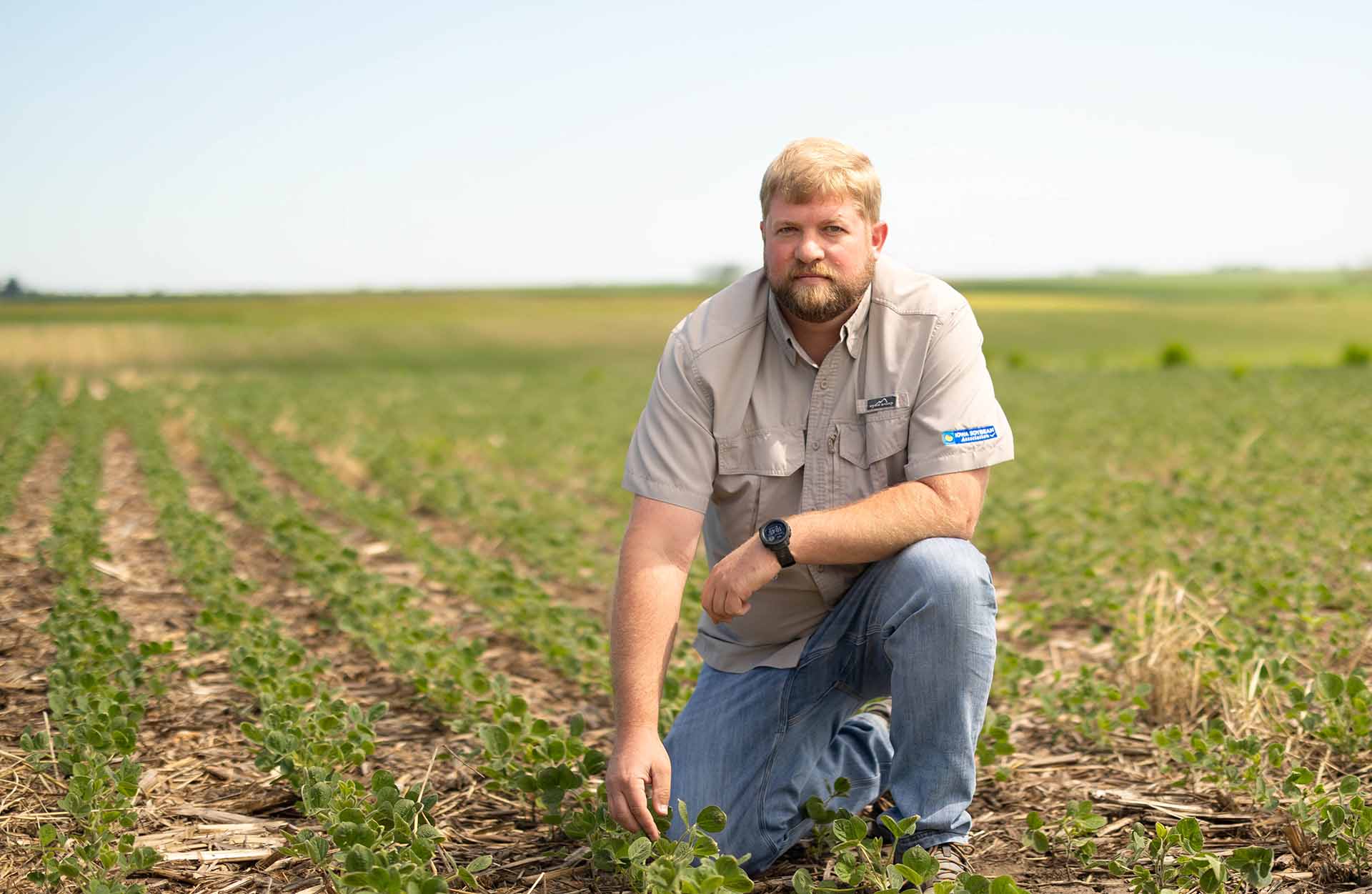
(Photo: Iowa Soybean Association / Joclyn Bushman)
Walking Rows 2025: ISA agronomist update – May 8
May 8, 2025 | Kriss Nelson
After a few weeks of waiting for field conditions to improve, farmers are back to planting.
Iowa Soybean Association (ISA) research agronomists report soil conditions have been prime, and farmers have been able to avoid planting in less-than-ideal conditions.
As crops emerge, research agronomists remind farmers to begin scouting for uniform emergence and early-season disease and insect pressure.
Alex Schaffer – Central/South Central Iowa
With the nice weather the rest of this week, most of the farmers I have checked in with hope to finish planting by the end of the week. Unfortunately for some, that includes some replant acres from the rains since Easter. The most affected part of my territory seems to be to the north from Webster to Hardin County, where they received 4-5 inches of rain, causing some ponding in fields.

Otherwise, the corn I see emerging around Des Moines and the surrounding areas looks nice. I see a lot of uniform emergence, and the “picket fence stands” everyone is after. Soil moisture is also in a good place right now. ISA’s research agronomy team has been doing a lot of soil sampling over the past couple of weeks, and the conditions are near perfect for easily pulling a quality soil core. Now, we’d be set for the year if it could rain an inch every Saturday evening.
There are no major disease or pest concerns given the current environmental conditions. However, the Iowa State University Moth Trapping Network captured some black cutworm moths in southeast Iowa. Keep an eye out, especially if you plant corn into standing cover crops.
Finally, I expect the crops that haven’t emerged yet will soon, especially with the warmer temperatures starting this weekend and next week, which should push things along.
Shane Beck – Northeast/Northern Iowa
This week, there has been a lot of activity in the fields following the rainy spell. A lot of planters, sprayers and tillage equipment have been rolling all over the countryside. The heavier rain created only a few wet spots; otherwise, field conditions look good.
It is important to check conditions frequently while planting and when changing fields. Adjustments may need to be made to depth, row cleaners, down force or closing wheel tension. Even with the rain delay, there is still potential for maximum yield. As long as corn is planted by mid-May and soybeans are planted toward the end of May, they should still have the potential to reach their maximum potential.

While scouting, I noticed some terminated cover crop fields where farmers used front-mounted booms, and cover crops in their wheel tracks were not being killed. There are streaks across the field where the wheels kicked up dust or rubbed the herbicide off the plant as it drove over. Proper installation and functioning of wheel nozzles are crucial. This can be extremely important when applying post-emergent herbicides. We do not want to have streaks of weeds where the wheel tracks are on our sprayers.
Mikaela Connelly — Southwest/West Central Iowa
A few days suitable for fieldwork last week allowed planters to return to the fields. This week has been a different story with conditions drying up and farmers working to get crops planted in districts 4 and 7. Some growers have completed planting, while others have switched from corn to soybeans. Other farmers have been switching between crops to keep planting as field conditions allowed. If the weather cooperates, most farmers will wrap up their planting in the next couple of weeks.
With the ideal moisture and temperature in the past couple of weeks, corn and soybean seedlings have started to pop through the ground, and soybeans in my area are at the emergence (VE) and cotyledon (VC) growth stage. I have noticed corn in the V1 stage in southwest Iowa.

I have noticed some crusting, but that’s to be expected given the moisture and the quick dry out because of warm temperatures.
We may see some in-season pests in the coming weeks as well. Since we are in the seedling stage, watching for bean leaf beetle damage is a good idea, as overwintered adults can cause early-season injury. Now that seedlings have emerged, also look for cutworm and armyworm.
Conditions are not favorable for early-season diseases. For example, warm, wet soils favor Phytophthora and Rhizoctonia, but wet, cool soils favor Pythium.
As the crops emerge, check your fields and conduct general scouting. It’s beneficial to double-check uniformity in your field because it’s likely that germination and emergence will vary depending on the soil type of your fields. Note these areas with lower emergence now so it’s not a mystery why yield might be lower in these areas at harvest. Although this spring hasn’t been as wet as last year, there could be other reasons for areas needing to be replanted, such as machinery breakdowns or equipment issues.
As I mentioned in the last Walking Rows segment, we’re still behind on moisture, so most parts of districts 4 and 7 remain abnormally dry.
With the nicer weather, I’ve been seeing more cover crop acres being terminated, and the fields I’ve seen have had good herbicide efficacy. Farmers should double-check the cover crop was terminated to avoid any surprises later in the season. To help decrease the possibility of creating herbicide resistance in future generations, change the herbicide mode of action when planning post-herbicide passes.
Craig Woods – Northwest Iowa
In district one, planting conditions appear rock solid, and rains have made it through the soil profile, which helps crops uniformly emerge.
Some farmers are done with their planting, and others are wrapping up corn and switching over to soybeans. They worked to get as much planting done as possible for the rain, which I believe was a blessing.

The current dry weather forecasts worry me about what that could do to pre-emergence herbicide. Dry weather could cause pre-emergent herbicides not to activate and reduce their availability.
Some slight soil crusting has occurred, but only at the top 1/4- to 1/8-inch layer of soil. I doubt that will be an issue, as the plants should be able to grow through it.
I have been collecting soil and plant tissue samples for ISA’s Improved Cropping trials. I have also been collecting cover crop biomass. This will help us better understand better management practices and how much nitrogen uptake happened through the accumulation of biomass.
Lucas De Bruin - Southeast/Eastern Iowa
District 9 planting is nearly complete, with an estimated 85% finished. I have been seeing more corn and soybeans popping up and I’m able to row them from the road.
In my area, 60% of cover crops have been terminated. I believe it took a little longer in some areas due to the spraying timing before a cooler and damp stretch, but it still got excellent termination.

District 6’s progress since my last report is significant; I’d estimate planting is 60% complete. Things have been drying out everywhere, allowing farmers to return to the field. Thankfully they don’t seem to be pushing the envelope, allowing conditions to be right and choosing not to mud their way across the fields.
This week and next, we will be busy before the next rain arrives. Farmers should monitor the fields for any early-season diseases in early-planted fields and determine if the seedlings have gone through those wet and cold periods. A reminder that last season, early-planted soybeans that had a damp and cool period early on also saw some diseases that started at this time last year.
Stay on top of spraying. You don’t want to let the weeds get ahead or miss a rain needed to activate the residual. If it is time to spray, even if the field looks clean, still spray it. The easiest weed to control is one that hasn’t come up yet.
Article by Kriss Nelson
Back